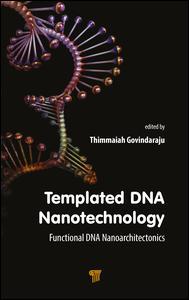Description
Templated DNA Nanotechnology
Functional DNA Nanoarchitectonics
Coordinator: Govindaraju Thimmaiah
Language: English
Subjects for Templated DNA Nanotechnology:
Keywords
MDA MB-435s Cell; Strain Promoted Azide Alkyne Cycloaddition; STAT3 siRNA; American Chemical Society; Guanine Quartets; Efficient Fret; UV Vis Titration; DNA Nanotechnology; Low Molecular Weight Gelators; Cd Signal; Anodic Photocurrent; DNA Nanostructures; Fret Efficiency; Branch PEI; Cd Spectroscopy; Hairpin; Hairpin Loop; DNA Condensation; Fullerene Derivatives; Guest Molecules; PDB Accession Code; Photocurrent Responses; ADR Cell; DNA Hairpin; HIV-1 Tat Protein
· 15.2x22.9 cm · Hardback
Description
/li>Contents
/li>Readership
/li>Biography
/li>
Nucleic acids have structurally evolved over billions of years to effectively store and transfer genetic information. In the 1980s, Nadrian Seeman?s idea of constructing a 3D lattice from DNA led to utilizing DNA as nanomolecular building blocks to create emergent molecular systems and nanomaterial objects. This bottom-up approach to construct nanoscale architectures with DNA marked the beginning of a new field, DNA nanotechnology, contributing significantly to the broad area of nanoscience and nanotechnology. The molecular architectonics of small "designer" molecules and short DNA sequences through complementary binding interaction engenders well-defined functional nanoarchitectures with realistic applications in areas ranging from biology to materials science and is termed "DNA nanoarchitectonics."
This book discusses novel approaches adapted by leading researchers from all over the world to create functional nucleic acid molecular systems and nanoarchitectures. Individual chapters contributed by active practitioners provide fundamental and advanced knowledge emanated from their own and others? work. Each chapter includes numerous illustrations, historical perspectives, case studies and practical examples, critical discussions, and future prospects. This book can serve as a practical handbook or as a textbook for advanced undergraduate- and graduate-level students of nanotechnology and DNA nanotechnology, supramolecular chemistry, and nanoarchitectonics and researchers working on macromolecular science, nanotechnology, chemistry, biology, and medicine, especially those with an interest in sensors, biosensors, nanoswitches and nanodevices, diagnostics, drug delivery, and therapeutics.
Multichromophore Stacks in DNA: Novel Light-Harvesting Systems. DNA-Programmed Nanoscale Assemblies of Covalently Linked Functional Monomers. Functional Molecule–Templated DNA Nanoarchitectures. Functional DNA Amphiphiles. Nucleoside Lipid–Based Soft Materials. Excited-State Dynamics in Chromophore-Appended Nucleic Acids. Templated Arrays of Multichromophores and Oligonucleotides Supported by Metal Interactions and Their Functional Relevance. Carbon Nanomaterial–Nucleic Acid Complexes and Their Biological Applications. Self-Assembled Functional Fullerenes and DNA Hybrid Nanomaterials for Various Applications. Nucleic Acid–Based Biosensors and Molecular Devices. DNA-Based Nanoswitches and Devices.
Thimmaiah Govindaraju is professor at the Bioorganic Chemistry Laboratory, Jawaharlal Nehru Centre for Advanced Scientific Research, Bengaluru, India. He received his MSc in chemistry in 2000 from Bangalore University, India, and PhD in chemistry in 2005 from the National Chemical Laboratory and the University of Pune, India. From 2005 to 2006, he pursued his postdoctoral research at the University of Wisconsin–Madison, USA, and from 2006 to 2008 the Alexander von Humboldt fellowship at the Max Planck Institute of Molecular Physiology, Dortmund, Germany. Dr. Govindaraju has published more than 90 papers in peer-reviewed journals and several book chapters and holds more than 10 patents. Many of his laboratory inventions have been commercialized or licensed to develop bioimaging and point-of-care diagnostics. He is also cofounder of a start-up company, VNIR Biotechnologies Pvt. Ltd. He has received awards such as "India’s Young Blood" by Chemical and Engineering News, ACS, USA, and the Sir C. V. Raman Young Scientist Award by the government of Karnataka (2014). He is also secretary of the Chemical Research Society of India (CRSI) and the Indian Peptide Society (IPS). His research interests are at the interface of chemistry, biology, and (bio)materials sciences and include Alzheimer’s disease (disease amyloids), peptide chemistry, molecular probes, molecular architectonics,
These books may interest you

Supra-materials Nanoarchitectonics 155.28 €



